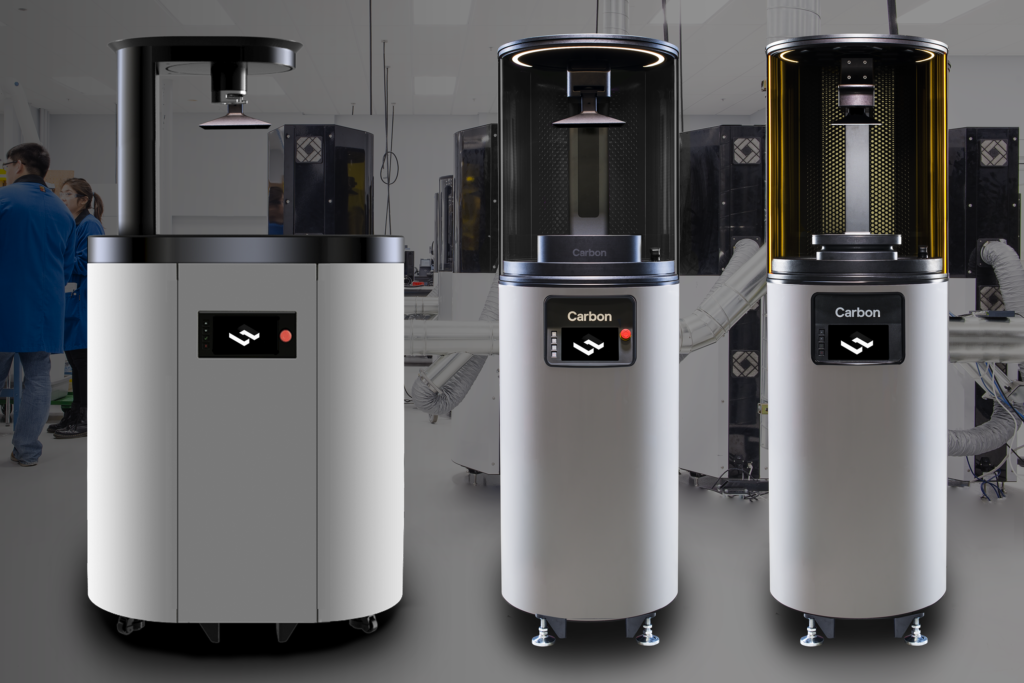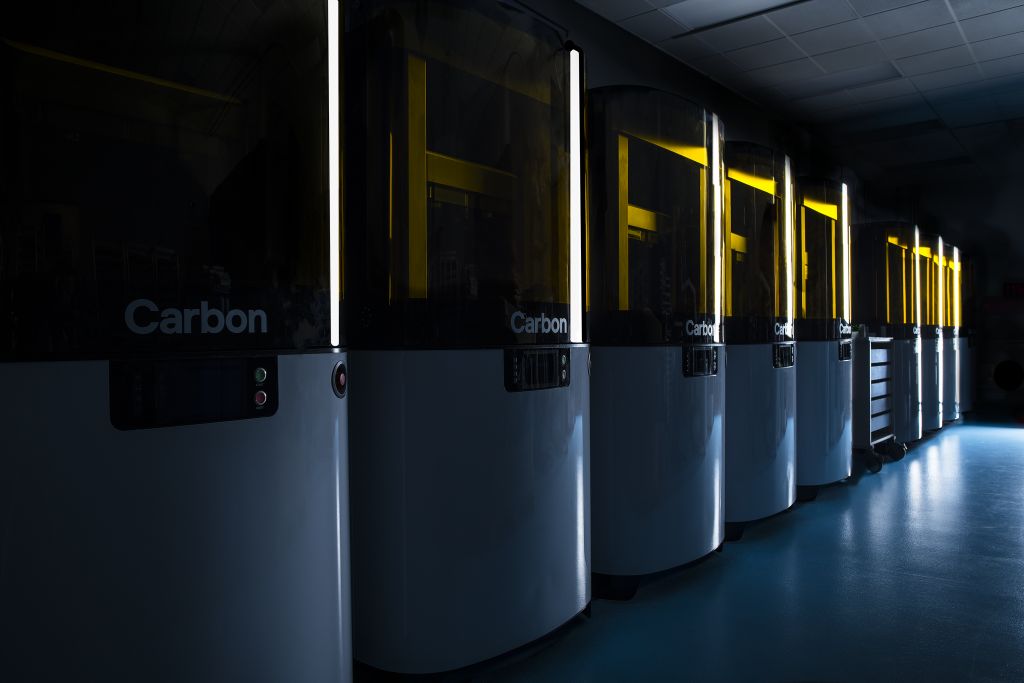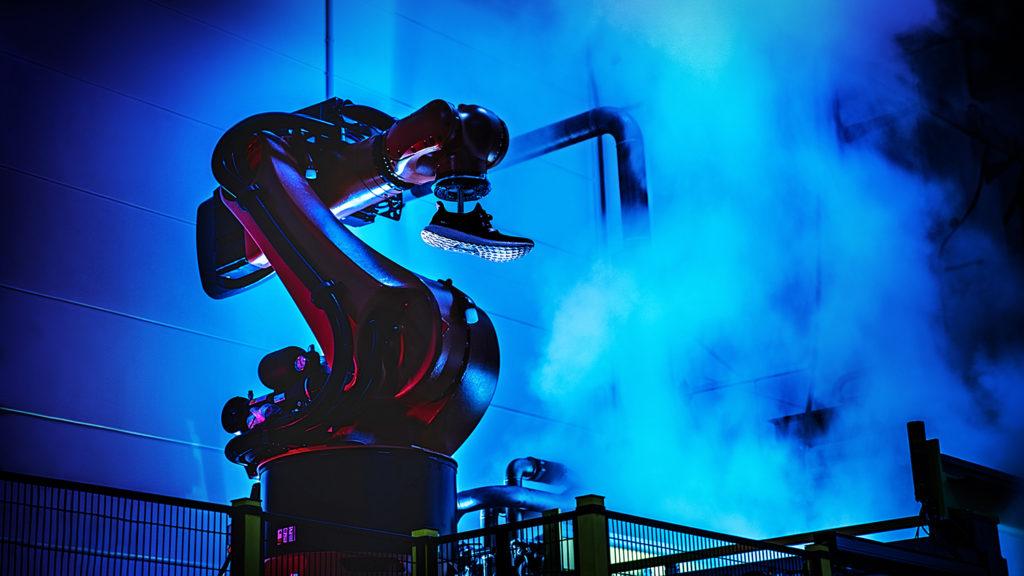When a privately held startup hits $1 billion in value, it magically transforms from an ugly mare into a beautiful unicorn (or so the legend goes). In the 3D printing space, there are three such creatures and we’ll be profiling each one. This time, we’ll be taking a look at Carbon.
Though the company was founded in 2013 (originally named Carbon3D), Carbon broke news and brains in 2015, when co-founder and CEO Joseph DeSimone gave a TED talk showcasing a prototype for the firm’s ultra-quick Continuous Liquid Interface Production (CLIP) technology. What was so brain-breaking about CLIP at the time was the fact that it was claimed that it could fabricate complete layer less objects in less than 10 minutes, 25 to 100 times the speed of other technologies on the market.
CLIP is now considered a form of continuous DLP 3D printing. The way it works is that a UV LED projector is cast through an oxygen permeable membrane onto photopolymer resin. Between the item being printed and the window is what Carbon calls a “dead zone” that consists of uncured resin. While light passes through the dead zone and cures the part, resin flows beneath into the dead zone to maintain the “continuous liquid interface”.
Unlike CLIP, with its continuous liquid interface, traditional DLP features the use of a mechanism to cleave printed parts from the print bed with each layer. Instead of spending time slicing the layer from the print bed, CLIP technology just keeps on going, allowing for seamless prints.
The speed is just the most obvious advantage of CLIP. The layerless nature of the process means isotopic parts, something previously virtually unseen in polymer 3D printing, typically hindered by weakness along the z-axis. Due to the unique chemistries developed in-house by Carbon, additional heat treatment in a forced-circulation oven applied to their 3D-printed parts activates engineer-grade strength. As a result, these parts are not just strong all around, but match the physical characteristics mass manufacturers are looking for in some end use components.
CLIP was brought to market with the M1 3D printer (build volume 144 x 81 x 330mm, resolution 75μm), which also introduced Carbon’s novel pricing scheme. Rather than purchase printers and materials, customers subscribe to them. With the M1, this meant $40,000 per year with a minimum three-year term got clients the printer, materials, software and support. Installation and training was $10,000. And an initial accessory pack was $12,000. Discounts were applied to the purchase of multiple systems.
After the M1 came the M2, which offered twice the build volume of its predecessor, as well as a Smart Part Washer, an automated method for cleaning parts after printing. With the new machines, DeSimone also explained that Carbon was developing modular technology that would make it possible to upgrade, attach, or automate systems.
The subsequent L1 3D printer, released just this past February, now serves as Carbon’s production-level machine, with ten-times the build volume of the M1 and five times that of the M2. Now, the M2 is billed as more of a prototyping or small-batch printing machine. Carbon advertises the fact that customers can now prototype using the exact same technology with which they will manufacture, providing a streamlined pathway from design to production.
Along with the printers, Carbon has released a number of materials that range from high-temperature resistant and stiff cyanate ester to flexible polyurethane to a range of FDA-compliant dental materials. Also, somewhere around 2017, Carbon began differentiating between its 3D printing process (CLIP) and the hardware that enables that process, referred to as Digital Light Synthesis (DLS).
Since Carbon’s launch, numerous other companies have unveiled their own form of continuous DLP 3D printing, some boasting benefits and speeds above and beyond CLIP. Prodways, Carima, and EnvisionTEC all demonstrated forms of continuous DLP. A Chicago-based startup called Azul 3D has designed a 3D printing system that prints even bigger and faster than CLIP.
What many challengers don’t have are the names that Carbon has brought on board in the form of partners, investors and members of the executive team. The firm’s four fundraising rounds between 2014 and 2017 have included Google Ventures, GE, Adidas, BMW and Johnson & Johnson. Craig Carlson from Tesla joined the company to lead its engineering team in 2014. Carbon’s board of directors includes former Ford CEO Alan Mulally and former DuPont CEO Ellen Kullman.
The partnership that seemed to catch some of the most headlines was that with Adidas, who, in 2017, announced that it would use Carbon’s DLS to create “Speedfactories” as a means of re-shoring European manufacturing. The effort was designed to replace the thousands of low-wage workers performing manual labor in Asia with a combination of Carbon 3D printers and other robots run by just 160 local Adidas employees. The goal was to produce, by mid-2017, 500,000 shoes with 3D-printed midsoles per year.
As we’ve recently learned, however, an aspect of the Speedfactory initiative has ended, specifically shoes with Boost midsoles. Joris pointed out that $43 per 3D printed midsole was a hefty price for a company dependent on cheap goods for maximum profits. He also exhibited concern for the longevity of the materials used for 3D-printed midsoles. Adidas has said that it will continue the use of Carbon technology for the production of midsoles and even plans to scale up in total.
The outlook for 3D-printed midsoles may not be as bleak as Joris initially speculated, or at least not on the surface, but it really is worth considering how much 3D printing will ultimately contribute to the re-shoring of jobs in the Global North while humanity simultaneously strives to repair our ecosystem. Can we continue to invent and implement new technologies for the production of wasteful consumer goods made from petroleum-based plastics if we want to reduce fossil fuel use and prevent ecological collapse? While we attempt to answer (or ignore) that question, our blissful unicorns can continue galloping forward onto new valuations.
Since fundraising efforts began in 2014, Carbon has raised a total of $682 million, with its latest Series E funding round in June of this year bringing in $260 million. The company is now valued at nearly $2.4 billion. That’s more than two whole unicorns!
Join the discussion of this and other 3D printing topics at 3DPrintBoard.com.
Subscribe to Our Email Newsletter
Stay up-to-date on all the latest news from the 3D printing industry and receive information and offers from third party vendors.
Print Services
Upload your 3D Models and get them printed quickly and efficiently.
You May Also Like
Johns Hopkins University Researchers Develop HyFAM Technology
Two scientists from Johns Hopkins University, Nathan C. Brown and Jochen Mueller, have developed a hybrid manufacturing technology they call HyFam, or Hybrid Formative Additive Manufacturing. Their work on this technology...
3D Printing G-Code Gets an Upgrade: T-Code
Good old G-Code still manages many 3D printers, great and small. Just like the STL, it’s a standard that enables collaboration while also holding the additive manufacturing (AM) industry back....
AM Rewind: The Biggest News and Trends of 2024
After a sluggish 2023, driven by persistent inflation and geopolitical tensions, 2024 has seen some recovery. Economic growth climbed from about 2.8 percent in 2023 to a modest 3.2 percent...
Metal Wire 3D Printer OEM ValCUN Announces Plans for 2025 Expansion
ValCUN, a Belgian original equipment manufacturer (OEM) of wire-based metal additive manufacturing (AM) hardware, has announced that the company has entered the next phase of its growth trajectory, making key...





































